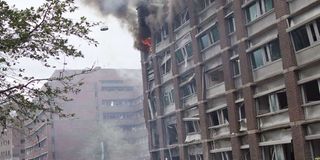Heritage: Is the world slowly giving it a back stage?

What you need to know:
- Refusing to create a memorial that remembers an act of terrorism is a bold political and cultural statement.
- Memorialisation of terrorist attacks has become more popular in recent years.
Kenyans may have read the book One of Us or watched the movie 22July.
Both tell the story of three inhuman acts.
One is the bombing of government buildings in the Norwegian capital, Oslo in 2011 and the killing of civilian population by a lone gunman.
The third is the shooting of seventy-seven young people at a summer camp organized by the workers youth league, of the ruling Norwegian Labour Party on the island of Utoya.
A national of Norway believed to be a right wing extremist perpetuated all these atrocities.
The bomb, which was placed near the government headquarters in a van damaged the tower block that housed the office of the then prime minister of Norway, Jens Stoltenberg, killed eight people and injured over two hundred others. On these particular buildings, Y and H blocks are murals designed by world famous Spanish artist, Pablo Picasso.
Two versions of the fisherman, the beach and the seagull designed by Picasso, in the late 50’s and early 70’s and executed by Norwegian artist Carl Nesjar are domiciled on Y block. The Fisherman faces a street façade, while the Seagull is inside the lobby of the building. The mural were the first attempt by Picasso at large concrete murals.
BRING DOWN BUILDING
The art works are in danger of destruction as the government has proposed to bring down the building and start construction of a new government building on the same site.
The demolition has been pending since 2014 when it was first proposed, with conservations and European architectural historians urging that it would constitute of a substantive destruction of Norwegian and European heritage.
The government had proposed to remove the murals from the building before construction workers bring it down and superimpose on the new government building that will come up on the same site. Conservationists and artists argue that such artworks cannot be the same once removed from their original home. They also consider it to be and unfortunate ‘wilful damage’ of art works.
They argue that this, in essence, is no different from the initial attempted destruction of these heritage by the terrorist bombs.
It also defies logic to attempt to remove the artworks as numerous amounts of money are spent on repair and restoration of arts works that have been damaged by human use and the wear and tear of time on the materials that were used to create them.
TERRORIST BOMBING
The more attention grabbing and provocative school of thought argues that the act of bringing down the building, which the Norwegian directorate of cultural heritage once considered for protection, would be completing the work started by a terrorist when they bombed and destroyed part of the building, an act said to be one of the most vicious home-grown attacks by a lone gunman on the civilian population in Norway.
Norway has not created a memorial for the bombings, but clearly, there are those who take the building and the art works as memory enough of those acts.
Memorials are strong reminders of who a people are and what they stand for or against at a particular place in time. Refusing to create a memorial that remembers an act of terrorism is a bold political and cultural statement.
Memorialisation of terrorist attacks has become more popular in recent years as western societies including Britain and America intensified campaigns internationally on the so-called war on terror. Acts of terrorism became so common that cities like London gave new guidelines indicating that memorials can only be created 20 years after the fact.
Now Norway is adding a new question to heritage memorialisation, “should home-grown terror be memorialised in the same way as external aggression?”
This in a silent way must be what Norway is posing to the world.
PEOPLE’S INNER RESILIENCE
A major reason for memorialising terror is to show people’s inner resilience, their ability to overcome a particular tragedy. What then does a society remember when that tragedy is home-grown?
Resistance of memory is also a discussion that Kenya must have.
We have a memorial in honour of those who lost their lives during the 1998 bombing, but none for victims of post-election violence, when we as a people terrorise each other. Some argue that continuous human effort is what creates resilience, not an isolated act of terror on a people. Others say that to remember is to learn.
Refusing to commemorate terror is bold statement on just how complex and intricate life is. It is an agreement that it cannot be celebrated from a specific reference point of terror and error. What we choose to remember cannot also be dictated by political goals alone either.
What message is Norway sending to the world? Are they choosing an identity and memory that is not dictated by politics or is the world slowly giving heritage a back stage as situations that threaten life itself take centre stage?





